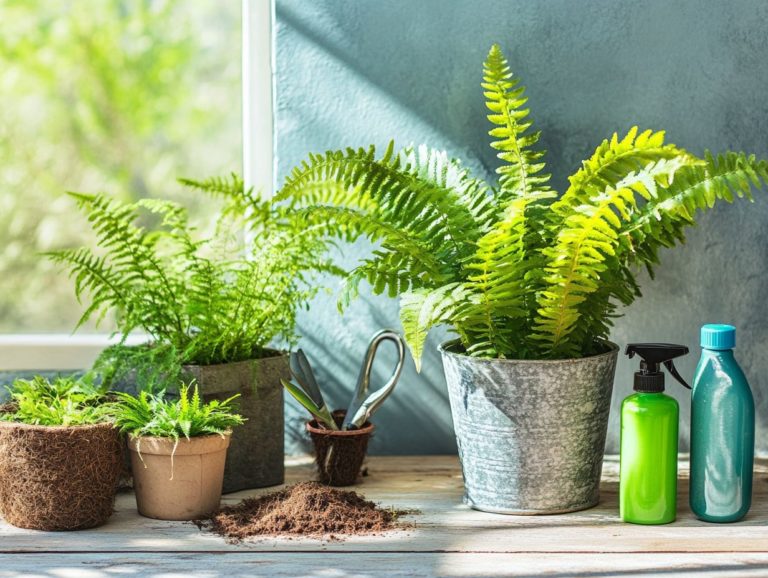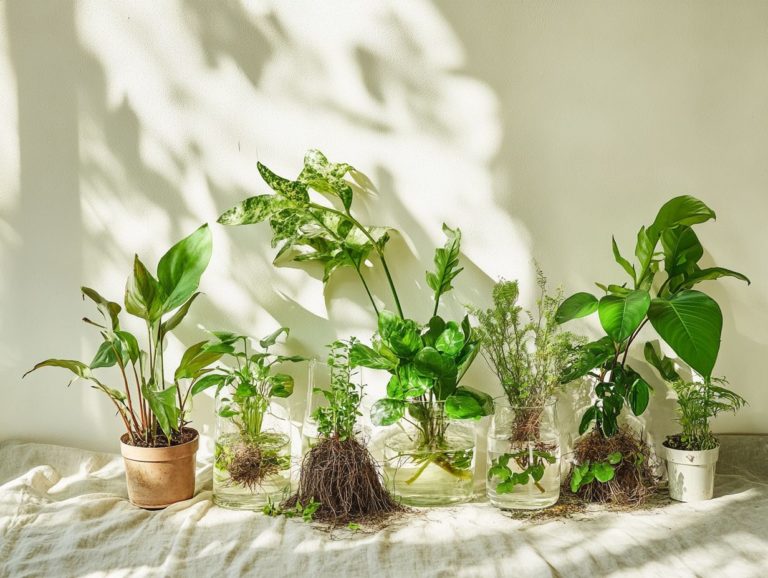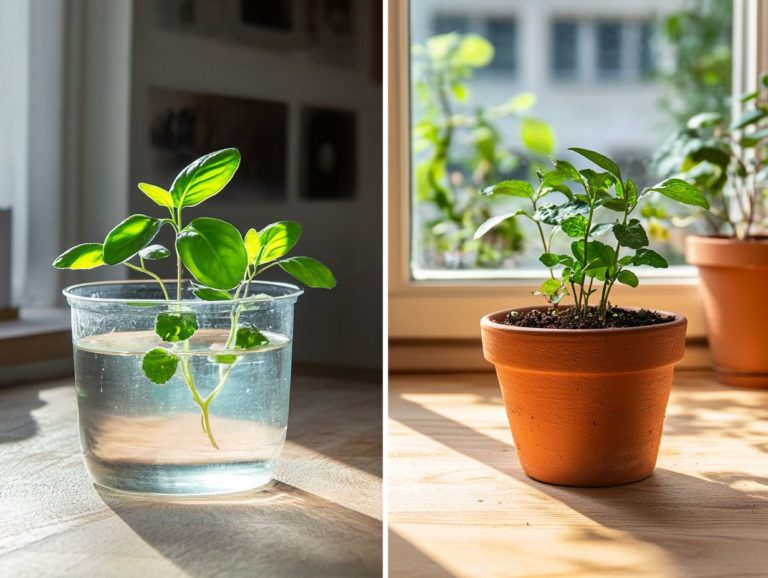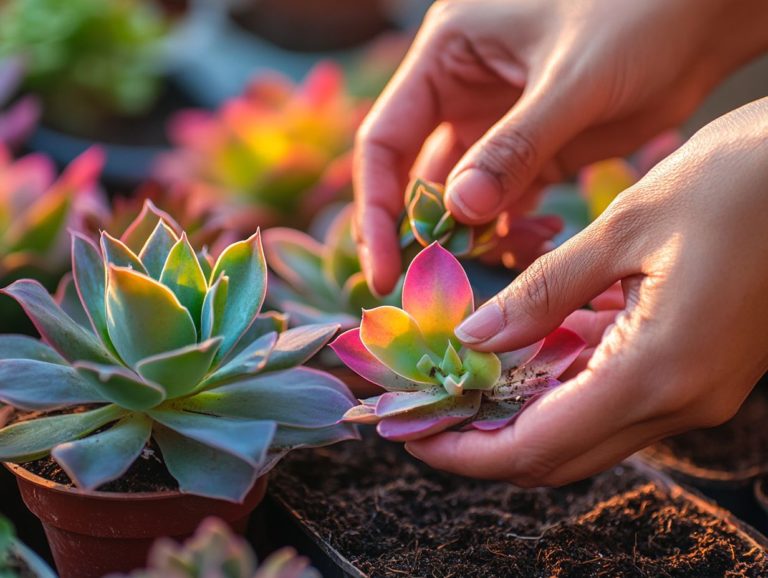Best Practices for Propagating Snake Plants
Snake plants, with their eye-catching leaves and remarkable resilience, have earned their place as a favorite among both beginners and seasoned plant aficionados.
Not only do they purify the air, but they also present a delightful opportunity for propagation, allowing you to cultivate new plants with ease.
This article delves into the advantages of propagating snake plants, exploring various methods such as leaf cuttings, division, and air layering. Discover best practices that will help your new plants thrive!
It also addresses common challenges you might face, empowering you to nurture a thriving indoor garden.
Contents
- Key Takeaways:
- Why Propagate Snake Plants?
- Methods of Propagating Snake Plants
- Best Practices for Successful Propagation
- Troubles? Let s Tackle Them Together!
- Frequently Asked Questions
- What are the best practices for propagating snake plants?
- When is the best time to propagate snake plants?
- What type of soil should I use for propagating snake plants?
- Can I propagate snake plants in water?
- What is the ideal temperature for propagating snake plants?
- How long does it take for snake plant cuttings to root?
Key Takeaways:

Regularly propagating snake plants keeps them healthy and adds new plants for your home or as gifts.
Successful propagation requires proper timing, tools, and planting techniques, whether you choose leaf cuttings, division, or air layering.
Nurturing your new plants with sunlight, water, and good soil prevents common issues like root rot and pests.
Overview of Snake Plants and Their Characteristics
Snake plants, also called Sansevieria trifasciata (or Dracaena trifasciata), are a popular choice for indoor plants that blend striking aesthetics with low-maintenance charm. These resilient houseplants thrive in a myriad of conditions, making them perfect for both the seasoned gardener and the absolute beginner.
With their upright, sword-like leaves showcasing various shades of green and yellow variegation, snake plants elevate your indoor d cor while also purifying the air. Their ability to adapt to different light conditions from bright indirect light to cozy low light further cements their reputation as favorites among home gardening aficionados.
Among the various types, the ‘Laurentii’ dazzles with its vibrant yellow edges, while the ‘Silver Queen’ enchants with its silvery-green tones. Each variety has its own care requirements, such as ensuring well-draining soil and allowing the potting medium to dry out between watering. This is essential for keeping your plants in top shape. The unique foliage characteristics some varieties even produce small, fragrant flowers add an extra layer of intrigue.
If you’re curious about propagation, you’ll be pleased to know that snake plants are a breeze to multiply through leaf cuttings or division. They not only make a beautiful addition to your home but also turn into a rewarding project for anyone keen on indoor plant care. For those interested in learning more, check out this guide on how to propagate Monstera plants.
Why Propagate Snake Plants?
Understanding why propagating snake plants is beneficial can elevate your home gardening experience and help you savor the advantages of flourishing plants. Propagation not only expands the number of snake plants in your space but also revitalizes their health and vitality through refreshing.
By looking into propagation experiments, you can experiment with various methods, from soil propagation to water propagation, enhancing your appreciation for these adaptable houseplants.
Furthermore, this practice offers economic benefits, allowing you to cultivate new plants without the expense of buying additional specimens. Don t miss out on the benefits!
Benefits of Propagation
The benefits of propagating snake plants go far beyond merely expanding your collection; they encompass enhanced plant health, cost savings, and an enriching gardening experience.
Engaging in this practice allows you to create new plants at little to no expense while simultaneously improving the air quality in your indoor environment. As these resilient plants thrive, their remarkable ability to filter toxins and convert carbon dioxide into oxygen becomes essential in crafting a more inviting atmosphere.
The satisfaction derived from nurturing a new snake plant through propagation deepens your connection to gardening, cultivating a profound appreciation for the natural world around you.
Ultimately, looking into the art of propagation not only saves you money but also enriches your living space and elevates your overall well-being.
Methods of Propagating Snake Plants
You can use several effective methods to propagate snake plants. Each method brings a unique way to enrich your plant collection.
From the straightforward elegance of leaf cuttings to the more careful method of rhizome propagation, understanding these techniques will help you choose the best option for your indoor gardening aspirations.
Whether you prefer soil propagation or the clarity of water propagation, each technique promises to produce robust new plants that elevate your living space and create a lush and vibrant environment.
Leaf Cuttings
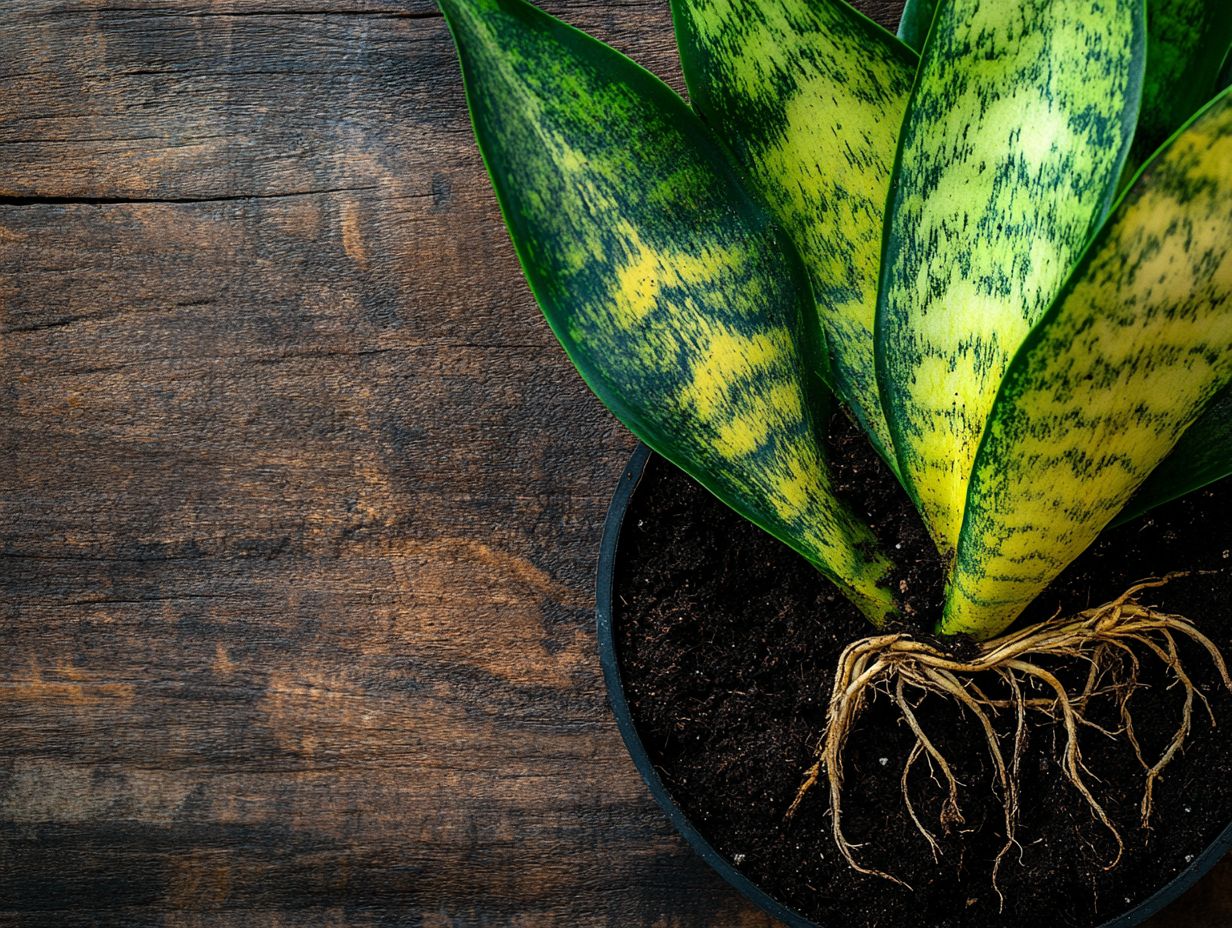
Leaf cuttings are a favored way to propagate snake plants. This method offers an effortless way to create new plants.
It revolves around selecting healthy leaves, slicing them into sections, and allowing the cut ends to callus before planting them in well-draining soil. This process not only encourages strong root growth but also enhances your chances of success, making it an excellent choice for both novices and seasoned gardeners.
First, pick vibrant, healthy leaves that are free from disease or pest damage. Trim each leaf into sections of about 4-6 inches, with a straight cut across the end to prevent moisture retention.
Let the cut sections dry out for a few days to prevent rot. Once adequately callused, you can plant the cuttings in individual pots filled with a cactus mix or well-draining potting soil, burying the cut end slightly.
Creating a warm and humid environment boosts your chances of successful rooting. Consider placing the pots in a location with indirect sunlight and controlled humidity for optimal growth conditions.
Keep a close eye on the moisture levels; the cuttings prefer the soil to be slightly damp but never soggy.
Division
Propagation by division is a highly effective way to multiply your snake plants. This technique utilizes the natural growth of rhizomes, which are underground stems that grow horizontally and can produce new plants.
This method involves carefully removing the plant from its pot, separating the rhizomes into multiple sections, and transplanting them into nutrient-rich soil for optimal growth. To learn more about how to propagate peace lilies effectively, consider checking out this guide on propagating peace lilies. By using this method, you can streamline plant maintenance and encourage diverse growth patterns among your snake plants.
To get started, you’ll need a sharp, sterilized knife or gardening shears. These tools are essential for making clean cuts and minimizing stress on the plant.
Timing plays a crucial role; early spring is the perfect moment as your plant emerges from dormancy, ready to thrive in fresh soil.
Once you’ve separated the rhizomes, it’s important to replant them immediately to prevent drying out. After the division, proper aftercare is key. Water the new plants lightly and position them in a spot with bright, indirect light to promote healing and growth.
Regularly check moisture levels while avoiding overwatering to enhance their development into healthy, vibrant specimens.
Air Layering
Air layering is a simple and effective way to grow new plants. This method allows you to root a stem while it stays attached to the parent snake plant. It not only boosts your chances of successful propagation but also encourages healthy plant growth.
To master this technique, start by wounding the stem, applying rooting hormone a substance that helps roots grow and wrapping it with moist sphagnum moss to promote robust root development. With a little patience and care, you’ll be amazed at how quickly you can grow new plants!
To kick off the air layering process, choose a healthy stem about the thickness of a pencil, ensuring it can support new growth. Make a small upward cut on the stem and apply rooting hormone directly onto the wound. It s essential to wrap the area with damp sphagnum moss to keep moisture levels stable and create an ideal environment for roots to flourish.
Covering the moss with plastic wrap helps retain humidity while protecting it from pests. You ll find the best conditions for success in a warm environment with indirect sunlight, which facilitates optimal root development.
The advantages of this method are plentiful. It allows you to propagate plants that can be tricky to root in soil and increases the likelihood of producing healthier, more resilient new plants.
Best Practices for Successful Propagation
Implementing best practices for successful propagation is essential for ensuring the health and vitality of your snake plants while maximizing their potential for new growth.
- Optimal light conditions significantly influence cuttings and robust root systems.
- Temperature regulation is critical during growth stages.
- Soil quality affects nutrient supply and root health.
By following these best practices, you can elevate your propagation success and enjoy flourishing plants in your indoor spaces.
Choosing the Right Time and Tools
Choosing the right time and tools for propagation is crucial for achieving optimal results in your snake plant endeavors. Timing plays a significant role in the success of leaf cuttings or division methods. Understanding the plant’s growth cycle and seasonal changes is essential.
Equip yourself with the right tools like sharp cutting implements and suitable pots to enhance the efficiency of your propagation efforts and ensure plant health.
The best time for propagation is spring, as it is ideal for new growth. Tools such as sterilized scissors or utility knives provide clean cuts, reducing damage and minimizing disease risk. For those looking to enhance their plant care, learning how to propagate ZZ plants can be particularly beneficial. Using appropriate soil mixtures and well-draining pots boosts root development, allowing your young plants to stabilize quickly.
This thoughtful approach to timing and equipment nurtures a stronger, healthier snake plant, ensuring its longevity and vitality in any indoor space. For those interested in expanding their plant collection, learning how to propagate spider plants can be a rewarding experience.
Preparing the Plant and Soil

Preparing your plant and soil effectively is essential for successful snake plant propagation. This gives your cuttings the best chance for robust root growth and vibrant health. Selecting a well-draining soil mix is crucial to prevent root rot while supplying necessary nutrients for your new plants.
The ideal soil should consist of a blend of potting soil, perlite, or sand to enhance drainage, mimicking the plant’s native conditions. Before propagating, allow your cuttings to callous over for a day or two to minimize rot risk.
Maintaining consistent humidity levels and avoiding direct sunlight during the initial growth stages is imperative; these conditions help prevent stress on the new roots. Ultimately, suitable soil, proper preparation of cuttings, and a controlled environment lay the groundwork for flourishing snake plants that enhance the aesthetic value and air quality of any space. For those interested in expanding their plant collection, learning how to propagate succulents successfully can be incredibly rewarding.
Don t miss the chance to try air layering for yourself it’s a rewarding experience that brings new life to your indoor garden!
Caring for New Plants
Caring for your new plants after propagation demands a keen focus on their environmental conditions and care practices to guarantee they thrive. Your snake plant cuttings will flourish under bright, indirect light to encourage healthy growth without overwhelming them.
Keep an eye on soil moisture; it s essential to prevent issues like root rot, a condition that occurs when plants get too much water, while providing the perfect balance of water and nutrients for ongoing development.
Regarding indoor plant care, it s vital to give these resilient plants a well-draining potting mix to avoid excessive moisture retention. Regularly check the top inch of the soil for dryness to determine when to water. This ensures they remain hydrated without risking suffocation.
Signs of a healthy snake plant include vibrant, upright leaves. Minimal yellowing indicates that it’s adapting well to its new environment. The success of your propagation efforts relies on consistent care, which includes occasional fertilization during the growing season to support robust growth and long-term vitality, along with effective propagation techniques for indoor plants.
Troubles? Let s Tackle Them Together!
Identifying and addressing common issues during propagation can profoundly influence the success of your snake plant endeavors, ensuring optimal health for your beloved greenery.
Some frequent challenges you might encounter include:
- Root rot from overwatering,
- Inadequate light resulting in weak growth, and
- Pests that could invade your newly propagated plants.
By staying aware of these potential hurdles, you can implement effective troubleshooting strategies. This will allow you to relish the rewards of your successful propagation experiments.
Identifying and Addressing Problems
Identifying and addressing issues promptly is crucial for maintaining the health of your propagated snake plants, especially during those vital early growth stages. Common challenges like root rot, often stemming from excessive moisture, and pest infestations can derail your propagation efforts. Spotting these problems early lets you jump into action and keep your plants thriving!
Yellowing leaves and stunted growth may indicate nutrient deficiencies. These could require a balanced fertilizer to restore optimal health. To prevent these concerns, it s essential to use well-draining soil and closely monitor your watering practices.
Regularly inspecting for pests like spider mites or mealybugs can help you catch infestations before they escalate. Providing adequate light and maintaining a consistent temperature will create a stable environment for their development.
By implementing these best practices, you can cultivate thriving propagated snake plants that remain robust and resilient through various challenges.
Frequently Asked Questions
Ready to dive into propagating snake plants? Here s what you need to know!
What are the best practices for propagating snake plants?
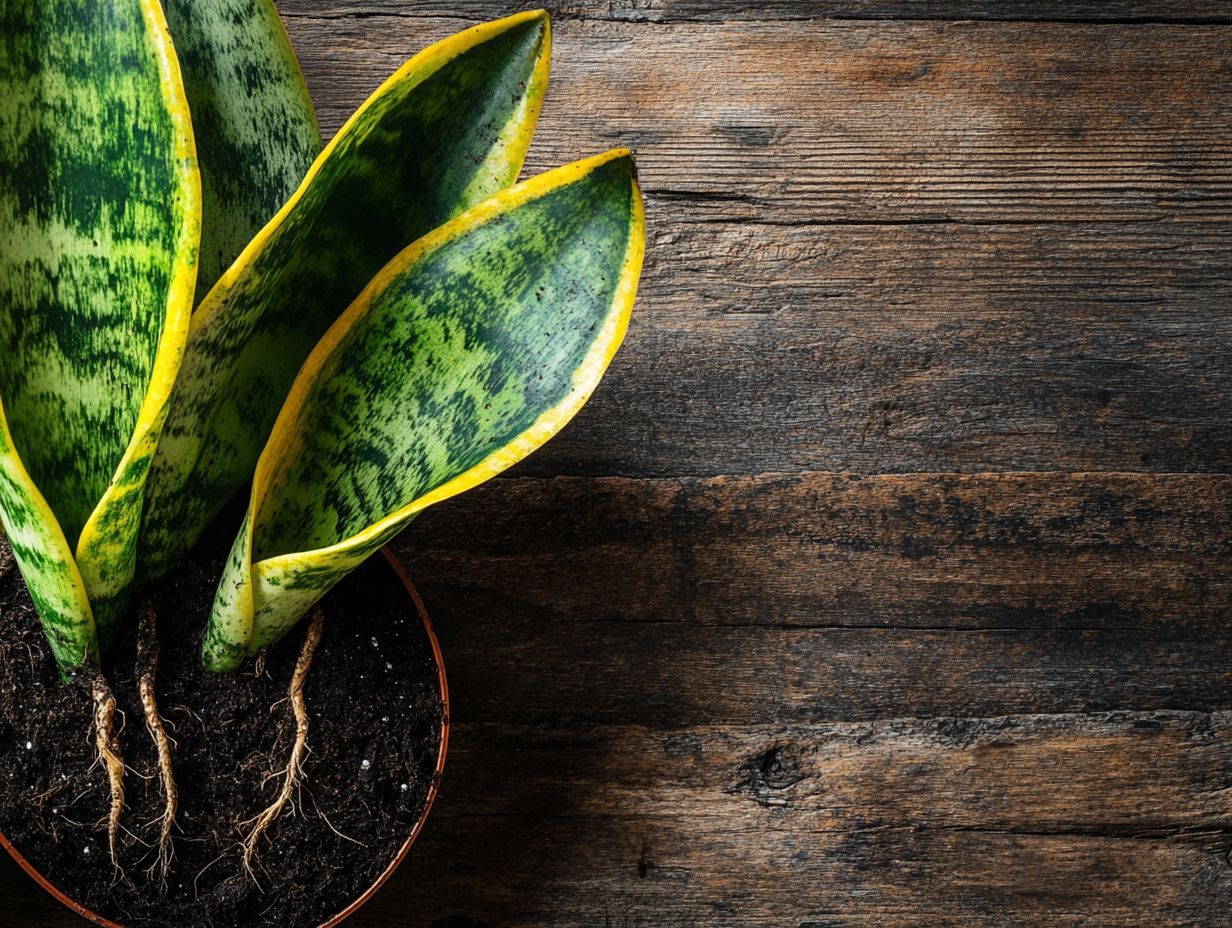
The best practices for propagating snake plants include using clean and sharp tools, choosing a healthy parent plant, and providing the right environment for the new plant to grow.
When is the best time to propagate snake plants?
The best time to propagate snake plants is during spring or summer when the plant is actively growing. Avoid propagating during winter when the plant is in a dormant state.
What type of soil should I use for propagating snake plants?
It is best to use a well-draining soil mixture, such as a cactus or succulent mix, when propagating snake plants. This will prevent water from pooling and causing root rot.
Can I propagate snake plants in water?
Yes, snake plants can be propagated in water. Simply cut a healthy leaf from the parent plant and place it in a jar of water, making sure the bottom of the leaf is submerged. Change the water every few days and wait for roots to form before planting in soil.
What is the ideal temperature for propagating snake plants?
Snake plants prefer temperatures between 70-90 F (21-32 C) for optimal growth. When propagating, it is best to keep the plant in a warm and humid environment, such as a greenhouse or under a plastic bag, to encourage root growth.
Now that you have the knowledge, it’s time to start your propagation journey!
How long does it take for snake plant cuttings to root?
It can take anywhere from 2 to 6 weeks for snake plant cuttings to develop roots. The time it takes depends on the conditions and the health of the original plant.
It’s exciting to watch your snake plant cuttings grow roots! With some patience, you ll see new plants sprouting in no time.

